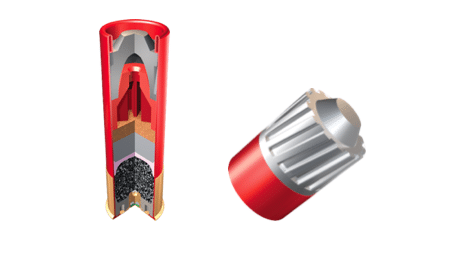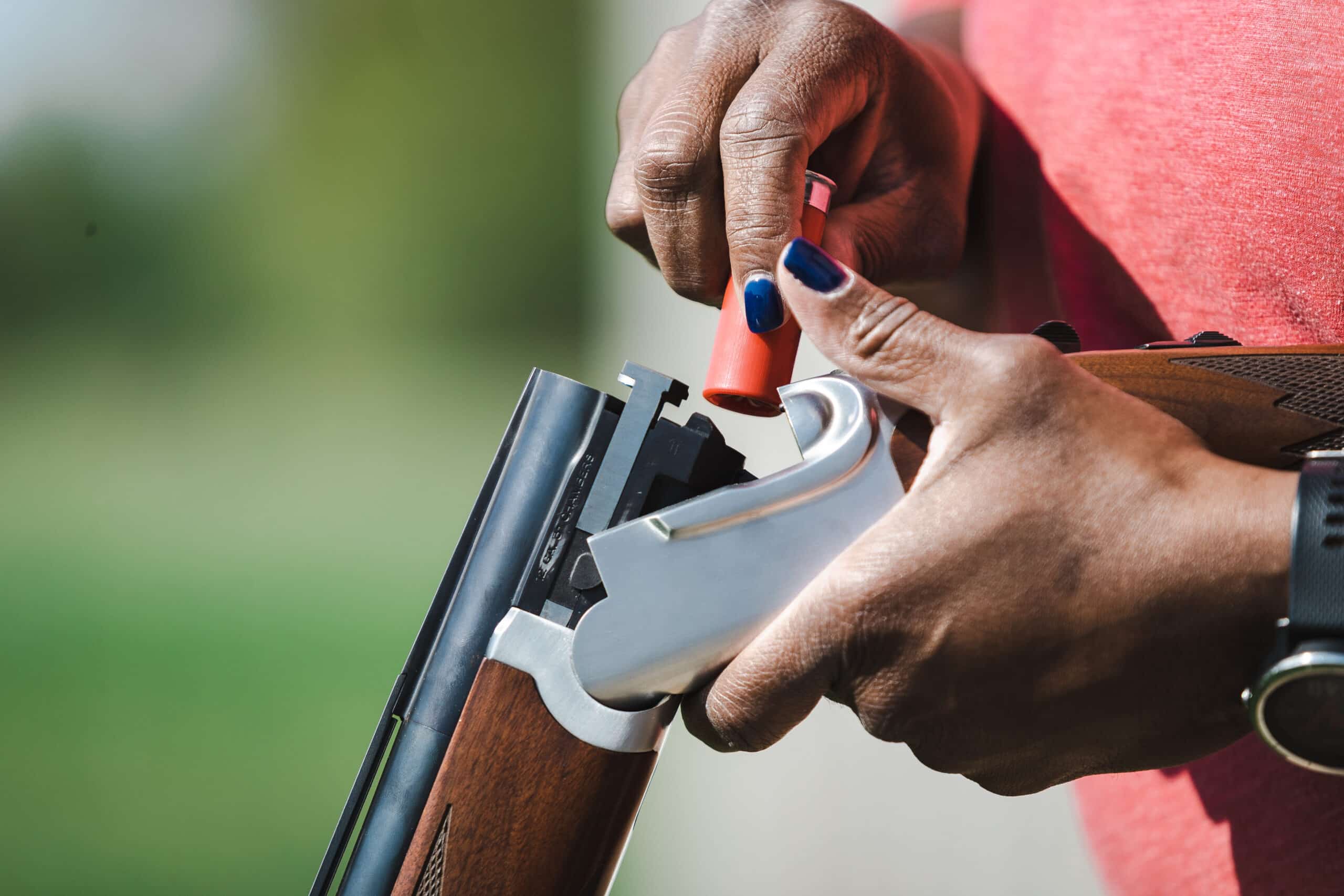Ammunition is a broad spectrum of products with several variations in each category that are all designed for different end uses. While there are several different ammunition products, they can be broken down into four different categories: Shotshell, Handgun, Rifle, and Rimfire.
For this article, we will be discussing Shotshell ammunition. Shotshell, like the majority of handgun and rifle ammo, is centerfire ammunition. Centerfire means that the primer, the component that ignites the powder and sends the bullet or pellets downrange, is in the center of the cartridge’s base. This is different from rimfire ammunition where the primer surrounds the entire rim of the cartridge’s base. For more information on rimfire ammunition, please refer to our Rimfire: The Perfect Intro to the Shooting Sports blog.
How does a shotshell work?
Pulling the trigger of a loaded shotgun releases the firing pin causing it to strike the primer, creating a mini explosion that ignites the powder. The ignition of the powder generates a gas that rapidly expands in the hull, forcing the wad and shot out of the top of the hull and down the barrel of the shotgun. The shot leaves the barrel in a tight pattern of projectiles that expands into a wider pattern as the projectiles travel farther downrange.

Fig.1 – For more information on Shotshell, Handgun, Rifle, and Rimfire ammo, view our Ammo 101 Graphics.
A shotshell consists of 5 components: primer, powder, wad, shot, and hull.
- Primer – The primer is responsible for igniting the powder.
- Powder – Smokeless powder is the propellant that the primer ignites and begins the process of sending the bullet or pellets, also called shot, downrange.
- Wad – A wad is a piece of plastic that separates the powder from the shot, provides a seal for expanding gases during ignition of the powder, and provides a barrier between the shot and barrel while traveling down the barrel.
- Shot – Rather than a single bullet, like handgun and rifle ammo, shotshells can contain hundreds of pellets. Designed to shoot at fast-flying clay targets and small game like dove, quail, and pheasant, this multitude of projectiles improves the odds of the shooter hitting a moving target.
- Hull – The hull is what contains all of the components listed above. A hull is a piece of plastic with a metallic base.
What does all of the info on the box mean?
Take a look at the graphic below to understand what each piece of information on your new box of shotshells means. We’ll break down the most important terms throughout the rest of the article.

Fig. 2 – Graphic breaking down the information found on a box of Shotshells
What does gauge mean?
Gauge refers to the measurement of the inside of a shotgun barrel. These measurements range from .410 bore (.410 is technically a caliber but that’s an exception) to 10 gauge. The lower the number, the larger the shotshell will be and the heavier payload it will have. Heavier payloads are more efficient at taking game or breaking clays due to having more pellets in each shot. However, the heavier the payload, the heavier the recoil. The higher gauges (i.e. 20 and 28 gauge) are preferred for their low recoil, but the sacrifice is often a lighter payload and fewer pellets. That being said, shoot what is the most comfortable for you. The most popular gauges are 12, 20, and recently 28. The .410 is also popular, especially for children.

Fig.3 – 12 Gauge Shotshell (Red) vs. 20 Gauge Shotshell (Yellow). Always check your firearm owner’s manual and the headstamp of the shotshell to ensure you’re using the correct ammunition for your firearm.
Shot Sizes
This is where shotshell ammunition starts to get technical. Before we begin, if choosing a shotshell for hunting, always refer to your local hunting regulations to ensure the shot size and shot material you select are legal for the game you are pursuing. For both hunting and sport shooting, it is also helpful to consult with a friend or family member who is an experienced shooter for advice on what size of shot you’ll need for your activity. As you become more experienced, you’ll start to understand what shot size works best for you and your hunting or sport shooting activity.
Smaller shot sizes are used for shooting clay targets and small game birds such as doves, quail, and pheasants. Larger shot sizes are best used for larger game such as ducks, geese, and wild turkey.
In addition to standard shot sizes, you’ll also find buckshot and slugs in shotshells. Buckshot and slugs both have hunting and personal defense applications. Buckshot is much larger than standard shot but each shotshell still contains multiple pellets. Slugs are single projectiles, similar to a rifle or handgun projectile, but are used in shotguns. We’ll get more into slugs later, for now, reference the chart below to understand the different shot sizes in standard shot and buckshot. Generally, the larger the shot number, the smaller the pellet.

Fig. 4 – Table illustrating standard shot and buckshot sizes.
Shot Weight
You’ll notice on the box of shotshells in fig. 2 there is the measurement 1 3/8 oz. This refers to the shot weight. The ounce weight in shotshell ammunition represents the total weight of the shot material contained in the shotshell. There are different shot weights available in the world of shotshell ammunition and these weights influence the pattern, range, and recoil of the specific load.
Shot Types
There are many different materials used to make shot and they each have different uses. Let’s break them down.
- Lead – Lead shot is the most economical choice and is typically used for target shooting and small game hunting. This shot may also be plated with copper to improve performance in magnum hunting and premium target loads.
- Steel – Used for waterfowl hunting and other uses like target shooting and small game hunting when the use of lead-free shot is required.
- Bismuth – Used in high-performance waterfowl and hunting loads, the advantage of bismuth is that it has a greater density than steel shot, which means bismuth pellets can be smaller and more pellets can be packed into the shotshell resulting in a heavier payload vs. a steel shot load.
- Tungsten – Also used in high-performance hunting loads, and with a density greater than both bismuth and lead, tungsten pellets can be even smaller which dramatically increases the pellet count and payload. Look for tungsten shotshells labeled as TSS (Tungsten Super Shot) for the ultimate high-performance shot.
Slugs
Designed for hunting medium to large game, slugs are a single projectile fired from a shotshell. There are two types of slugs, rifled and sabot slugs. This is confusing but rifled slugs are used in smoothbore shotgun barrels and sabot slugs are used in rifled shotgun barrels.
- Rifled Slugs – These slugs are made of lead and often have a hollow point and distinctive grooves around the projectile. The maximum effective range of rifled slugs is around 100 yards.
- Sabot Slugs – For use in rifled barrels, sabot slugs are smooth sided projectiles that often have copper jackets and may even have a polymer tip for increased accuracy and penetration of medium to large game. The maximum effective range of sabot slugs is around 125 to 150 yards.
Always refer to your firearm owner’s manual to understand what ammunition your firearm is rated for.


Fig. 5 – Rifled slug cutaway view (top left). Rifled Slug projectile (top right). Sabot slug cutway view (bottom).
Common uses of Shotshell Ammunition
Now that we have an understanding of shotshell ammunition, let’s take a look at how they are commonly used.
- Personal Defense – Shotguns have been used as personal defense firearms for a long time. More recently, ammunition manufacturers have been creating shotshell ammunition with special technology specifically designed for personal defense.
- Target Shooting – Clay target shooting is currently the fastest growing sport in the United States. This is due to the fact that it is a fun activity accessible to everyone from weekend recreation shooters to Olympic athletes and competition shooters.
- Hunting – Shotguns and shotshells are extremely popular for hunting a variety of game, from larger game like deer and turkey to smaller game like dove, quail, and everything in between.
There is a lot of information to take in about shotshell ammunition and this article is just a start. The best way to learn is to start by seeking instruction from a qualified instructor, be safe, have fun, and get out there and shoot.


